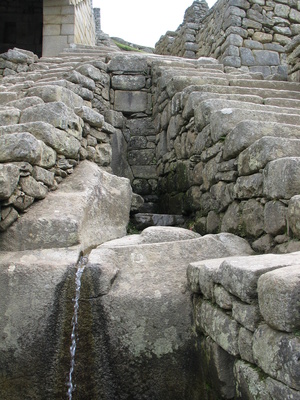The Liturgical Fountains of Machu Picchu
 This magnificent building has received many names throughout history, due to the large number of anthropology studies that have been identifying the different construction elements and buildings of the entire city of Machu Picchu. The "street of the fountains ", "staircase of the fountains" or, mostly known as "liturgical fountains", are some of the names for this group of water tanks or pools that were named by the Inca civilization as "paqchas". But these sixteen fountainshold a meaning that goes beyond the obvious decorative purpose; they have a high spiritual and sacred value as many of the buildings of the city of Machu Picchu, citadel that was built according to the religious beliefs of the Inca civilization. This civilization used to believe that the natural elements, like water or fire, were actually gods, originating the Inca mythology.
This magnificent building has received many names throughout history, due to the large number of anthropology studies that have been identifying the different construction elements and buildings of the entire city of Machu Picchu. The "street of the fountains ", "staircase of the fountains" or, mostly known as "liturgical fountains", are some of the names for this group of water tanks or pools that were named by the Inca civilization as "paqchas". But these sixteen fountainshold a meaning that goes beyond the obvious decorative purpose; they have a high spiritual and sacred value as many of the buildings of the city of Machu Picchu, citadel that was built according to the religious beliefs of the Inca civilization. This civilization used to believe that the natural elements, like water or fire, were actually gods, originating the Inca mythology.
Pariacaca was one of the most venerated Inca deities because he is the representation of the god of water. The Inca mythology believes that he was the almighty creator god who was once a falcon before he turned into a human. The whole culture, and the city itself, are based on the element water. This is clearly seen in the infrastructures of the city of Machu Picchu, a city that offered its citizens the opportunity to pray and worship Pariacaca, the god of the water that was represented by the significant number of fountains. The set of fountains receives the water from the numerous springs located several kilometers, very deep inside of the mountains, where the civilization developed a collection system to provide the city with the most important natural resource; the system would collect the water from the rain through streams, watercourses, torrents and brooks to supply the city. The water would be collected to fill in the various channels all over the landscape and its different terraces. These flat surfaces facilitated the creation of fonts and some ponds that were intended for the essential use of water as an essential element of nature, both for the practice of rituals and religious idolizations.
The exact location of the liturgical fountains was chosen strategically, constructed between two of the most important buildings of the city: the Temple of the Sun and the Royal Palace. This two buildings and the alley created in between them, is what we know now as the "Street of the Liturgical Fountains".
The set of fountains all over the slopes of the mountains forms what is called the great "stairway of liturgical fountains," staircase that contains these sixteen fountains or ponds of water. The set shows an incredibly fine work using high skills and construction techniques such as craftsmanship and masonry to create, on stone, various channels and sinks that constitute this water collector system, more commonly known as aqueduct. The construction also shows a number of polygonal rocky ridges and their meaning could have been also religious.
There is a main fountain located in one of the most significant buildings of the Inca culture known as Wayrana, a three walls construction that could have been used as spiritual Centrefor religious ceremonies and sacred rituals where the citizens would worship the God of water. At the present time, the water from these springs has been held in reserve to supply the several touristic resorts located in the area, so the water is no longer running through these water channels.